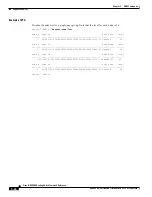
5-79
Cisco MGX 8850 Routing Switch Command Reference
Release 2.0, Part Number 78-10467-04 Rev C0, October 2001
Chapter 5
PNNI Commands
dsppnni-node
Restricted transit
Display the flag that indicates whether transit is restricted across this node.
This value can be set to off to secure the node, or to minimize traffic handled
by the node if it is of either low-capacity or high-criticality.
on: Calls can transit across this node.
off: Only calls terminating on end-systems supported by this node can access
this node.
Complex node
Indicates whether this node is a complex node. A node at the lowest level
cannot be a complex node. Therefore, in the current release, this field always
contains “off.”
on: This node is a complex node.
off: This node is not a complex node.
Branching restricted Indicates whether the node supports point-to-multipoint branching.
on: This node does not support point-to-multipoint branching.
off: This node supports point-to-multipoint branches.
Admin status
Display the administrative status of the node. You can disable or enable a node
by executing the cnfpnni-node command with appropriate parameters.
up: The logical PNNI node is enabled.
down: The logical PNNI node is disabled.
Operational status
Display the operational status of the node. The software determines the
operational state, so you cannot configure it.
Non-transit for PGL
election
Display whether transit is restricted across this node. This value is set by the
software and is not user-configurable.
on: Only calls that terminate on this node can access this node.
off: Calls can transit this node.
Node id
For the constituents of the node ID, see the description of addpnni-node or
cnfpnni-node. Before you change the node ID, you must disable the node by
entering cnfpnni-node -enable false. See description of cnfpnni-node.
















































